|On July 8, Texas Governor Greg Abbott issued an open letter to the people of Texas.
Entitled, “A Time To Come Together,” it followed the deadliest day for police in modern US History since September 11, 2001.
Just yesterday, shortly before 9 PM, Army Veteran, Micah Xavier Johnson opened fire on police officers in Dallas Texas, killing 5 officers and wounding seven others. As of Friday afternoon, the names of the five police officers shot dead had been released. Those identified were Brent Thompson, Michael Krol, Patrick Zamarripa, Michael Smith, and Lorne Ahrens. Of these five slain officers, three were military veterans.
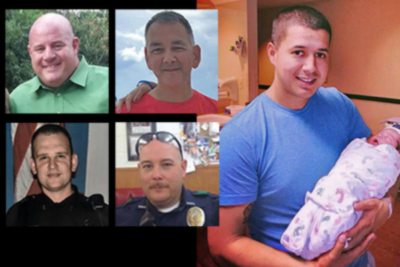
Thompson was a former US Marine who had served in Iraq and Afghanistan to train and guide local police. The 43-year-old police officer was a newly married grandfather who joined the Dallas Area Rapid Transit Police Department back in 2009.
Patrick Zamarripa was a Navy veteran who had survived three tours in Iraq before joining the Dallas Police Department. He joined the Navy shortly after high school in Fort Worth, serving eight years on active duty and then in the reserves. He returned to Texas in 2009. Zamarripa leaves behind a wife, and two kids—a 2-year-old daughter, Lyncoln, and a 10-year-old stepson.
Sergeant Michael Smith was a father of two. The 55-year-old was a former Army Ranger who joined the Dallas Police Force in 1989.
Michael Krol worked with the Dallas Police Department for 8 years. Previously he worked in the jail system of the Wayne County Sheriff’s Office in Detroit, Michigan, from 2003 to 2007. According to his uncle, “[Michael] got into law enforcement and worked really hard to be a police officer.” The 40-year-old Michigan native worked difficult jobs, waited years, and moved more than 1,000 miles to achieve his dream of becoming a police officer.
Senior Corporal Lorne Ahrens was a member of the Dallas Police Department for 14 years, since January 2002. The 48-year-old officer hailed from California and was married to Detective Katrina Ahrens from the Crimes Against Persons Division. The couple lived in Burleson with their two children, 8-year-old Magnus and 10-year-old Sorcha.
What began as an initially peaceful protest—in response to the deaths of Alton Sterling in Louisiana and Philando Castile in Minnesota—turned violent as a total of 12 police officers and 2 civilians were shot. The attack was carried out by “snipers” who fired from “elevated-ground.”
Micah Xavier Johnson, 25, identified as a suspected gunman, was killed after authorities cornered him in a garage at El Centro Community College. After several hours of negotiations, lasting into the early hours of Friday morning, officials exchanged gunfire with the suspect and “saw no other option” but to kill him by detonating a bomb, Police Chief David Brown said. Brown said the attacker told authorities “he was upset about the recent police shootings” and “wanted to kill white people, especially white officers.” The suspect told authorities that “the end is coming” and spoke about bombs being placed downtown, but no explosives had been found by Friday morning. The Dallas Police Chief told reporters that it’s too soon to speculate on the suspect’s motives, and it’s unclear whether more suspects are on the loose.
Brown also mentioned, during the news conference, “the investigation has revealed to us this was a well planned, well thought out, evil tragedy by these suspects.”
An army spokeswoman confirmed that Johnson was a reservist who served in Afghanistan from November 2013 to July 2014. The Texas resident was an active reservist for six years from 2009 to 2015, holding the rank of Private First class and specializing in carpentry and masonry. He also served general guard duty, but there is no evidence that he participated in any combat. Johnson left the Army Reserve in April 2015. Military sources say he was transferred to the Individual Ready Reserve, making him no longer connected to a unit or required to continue drilling. Johnson’s awards included the Afghanistan Campaign Medal with campaign star, the Army Achievement Medal, the National Defense Service Medal, the Army Service Ribbon, the Armed Forces Reserve Medal with “M” Device, the NATO Medal, and the Global War on Terrorism Service Medal.
Yes, it’s that word race … and we’ve got to attack it head on.
How can law enforcement possibly secure Peace in a fractured Nation?
Dallas Mayor Mike Rawlings spoke candidly and movingly during a Friday afternoon vigil for the fatal shooting. “Yes, it’s that word race,” he said, “and we’ve got to attack it head on.”
None deny that lines of racial division have been drawn. None deny that issues of race are a factor in law enforcement and the dynamic within communities — issues which have resulted in often senseless and tragic deaths in the black community. Police, more than ever, are tasked with managing community expectations and maintaining the peace, all amidst a powder keg of racial tension.
Lima Charlie’s News Team is comprised, in part, of veterans who have experience training police forces in both Iraq and Afghanistan, areas suffering from harsh and brutal ethnic and religious divisions. Lima Charlie’s veteran correspondents have served as Advisers to Iraqi Army troops, Police Intelligence Advisors in Northern Afghanistan, and Advisors and Trainers to police and SWAT teams in sniper employment operations. Building relationships with foreign military and police requires both tactical and historical context to better understand the violent frictions between deeply opposing sides whether racial, ethnic, or religious in nature. The complex relationship between police and communities must be understood.

There is no obvious panacea to what will inevitably become a highly politicized shooting. However, the past offers some insight into plausible directions, where even the most hated and vilified were able to reach compromise, and even mutual respect between law enforcement and the community.
A long way in time and distance from Dallas, the Royal Irish Constabulary (RIC) was a paramilitary entity tasked with maintaining law and order in Northern Ireland beginning in 1836. It had a reputation for being majority dominated by Protestants and fiercely opposing Catholics on the other side of the divide, leading to over a century of tumultuous, ongoing violence and senseless killings, centered around race, religion and politics. Age-old animosities between the groups left a violent situation without any end in sight. The RIC (later RUC), maintained a checkered past of cold-blooded assassinations and attacks on Catholics.
In 2001, however, a monumental transition took place. The Police Service of Northern Ireland (PSNI) was formed, as successor to the RUC. Although most members of this force were Protestants, for the first time in more than two centuries the police force successfully quelled, in large part, the tumultuous tides between Protestants and Catholics. One of the crucial contributing factors to their success in assuaging these hostile tides was their new characterization as an exclusive police force, largely removing the paramilitary functions from their lexicon. Today, they are the model for the best police force in the world.
The PSNI maintained the peace by reassessing their predecessors’ contentious history of policing, and devoting themselves to the sole role of police officers, rather than paramilitary troops. They successfully integrated themselves into the communities they served and preserved more peace than the opposing factions had ever seen. Today, Northern Ireland’s police reform is heralded as a paradigm for other post-conflict countries. The transition from the RUC to the PSNI was largely successful because of this change in both mentality and in function.
We’re not the military. Nor should we look like an invading force coming in.
– Salt Lake City Police Chief Chris Burbank
Did troubled times call for extreme measures?
The Posse Comitatus Act, passed in 1878, prohibits the nation’s armed forces from being used as a police force within the United States. As the logic goes, soldiers exist to fight battles.
Beginning in the 1990’s, increased threats to the American public, such as terrorism, both foreign and homegrown, the ongoing War on Drugs, culminating with the September 11th attacks, lead to a gradual and increasing militarization of our nation’s police forces. This was compounded by the massive military expenditures of the War on Terror, where billions of dollars in surplus military equipment and vehicles made their way to police departments nationwide.
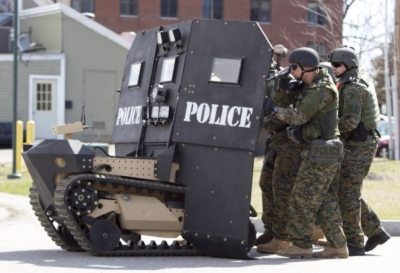
Police departments today consist of such heavy weapons as M-16 rifles, armored trucks, Bradley Fighting Vehicles, and grenade launchers, that the basic principal underlying this Posse Comitatus Act has gone awry.
The American public shares in this apprehension. A Reason-Rupe poll released in December 2013 found that 58% of Americans believe police militarization has gone too far. The onset of militarized policing has long been growing in the body politic, ever since the first Special Weapons and Tactics (SWAT) teams were born in the 1960’s in response to that decade’s turbulent mix of riots and senseless violence, like Charles Whitman’s infamous clock-tower rampage in Austin, Texas.
When the notion of SWAT first arose out of Los Angeles and Philadelphia Police Departments, the policing style was quickly picked up by big city police officials all over the country. What began as an elite force reserved specially for uniquely dangerous scenarios—active shooters and hostage taking situations—rapidly evolved. By 1984, 26% of towns with populations between 20,00 and 50,000 had SWAT teams. By 2005, 80%, and, today the number is rising. Yearly, there are about 50,000 SWAT raids in the United States, in what amounts to a daily count of 137 SWAT team assaults on homes.
SWAT Teams, however, are not the only indicator of the growing militarization of our police forces. Across America, according to Karl Bickel—senior analyst with the Justice Department’s Community Policing Services Offices—police training is increasingly modeled on military boot camps rather than the more relaxed academic setting that a minority of Police Departments still use. This more authoritarian angle runs at odds to the core philosophy that typically dominated twenty-first-century American thinking: community policing. The community model is the official policing philosophy of the United States Government. Under this philosophy, officers place their roles as protectors and problem solvers at the forefront of their minds, living by the notion that they must care, first and foremost, about how their communities see them.
Even police recruiting videos, such as those in the California Newport Beach Police Department and New Mexico’s Hobbs Police Department, place significant emphasis on militarization—rather than community—attracting young men with the promise of Army-style gear and gadgets, and adventure.
Right down to the dress code, we observe what is perhaps the most visceral evidence of increased militarization of our police. What was once suit and tie attire has transformed into battle-dress uniforms (BDU’s) for patrol officers—militaristic, often black, jumpsuits—making them less approachable and likely more aggressive in their interactions with the community.
Under the community model police officers place their roles as protectors and problem solvers at the forefront, living by the notion that they must care, first and foremost, about how their communities see them
Some politicians have been highly outspoken about the trend. Rand Paul, Republican senator from Kentucky and former contender for his party’s presidential nomination in 2016, has argued that we have reached a point where we must “demilitarize the police.” Legislation has not been forthcoming in dealing with this growing issue. In June 2014, a Democratic representative from Florida sponsored an amendment forbidding the Defense Department from transferring to local police aircraft (aerial vehicles), armored vehicles, toxicological agents, launch vehicles, grenade launchers, silencers, guided missiles, ballistic missiles, rockets, torpedoes, bombs, mines or nuclear weapons. The bill failed on both sides of the aisle.
The U.S. Defense Logistics Agency, through its 1033 program, is one of the primary enablers of America’s police militarization. In one single page of a 450-page law, Congress approved the Pentagon to transfer its surplus property free of charge to federal, state, and local police departments to wage the War on Drugs. Seven years later, the legislative body expanded the program to include counterterrorism.
An examination of police militarization could not be conducted without also mentioning the pushback gleaned from current and previous police officials who have recognized this trend. Salt Lake City Police Chief Chris Burbank has been a vocal critic of militarization, saying:
“We’re not the military. Nor should we look like an invading force coming in.”
Retired Seattle Police Chief, Norm Stamper, is also a critic of this practice, offering, “most of what police are called upon to do, day in and day out, requires patience, diplomacy, and interpersonal skills.” His support for militaristic solutions to the World Trade Organization protests is a decision he wishes he could take back. “My support for a militaristic solution caused all hell to break loose,” he reported in the Nation. “Rocks, bottles and newspaper racks went flying. Windows were smashed, stores were looted, fires lighted; and more gas filled the streets, with some cops clearly overreacting, escalating and prolonging the conflict.”
As we reassess the relationship between the police and communities, as we tackle head on the issue of race in America, we must attack the matter from all possible vantage points. Considering new demilitarized manners of training and employing our police forces, and reassessing how we can improve integration of our police officers into the neighborhoods they serve is just one such approach.
Concurrently, communities must rise together and strive to meet law enforcement at least half way in tackling what is often a highly dangerous and exceedingly stressful profession, where life and death, and returning to family at the end of a shift, are not certainties.
Above all else, we must hold in our minds the memory that, 52 years ago, a sniper in Dallas, Texas vowed to draw a further rift in race relations in America. It didn’t work then and it won’t succeed now.
Lima Charlie News, with Anthony A. LoPresti and Joseph Labarbera
Lima Charlie provides global news, analysis and opinion by military veterans and service members Worldwide.
Please join us on Twitter at @LimaCharlieNews
#LimaCharlie #LimaCharlieNews

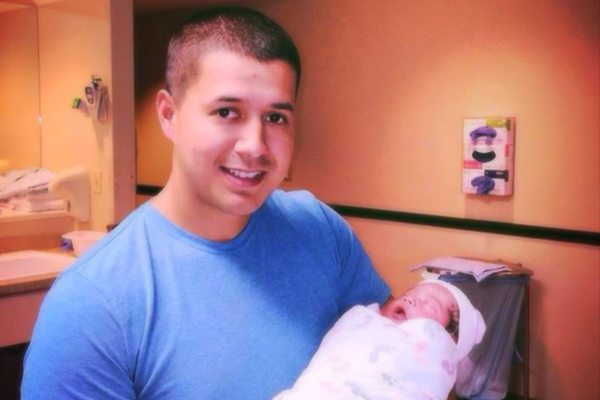
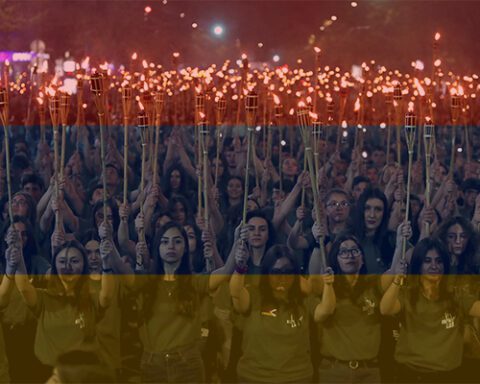


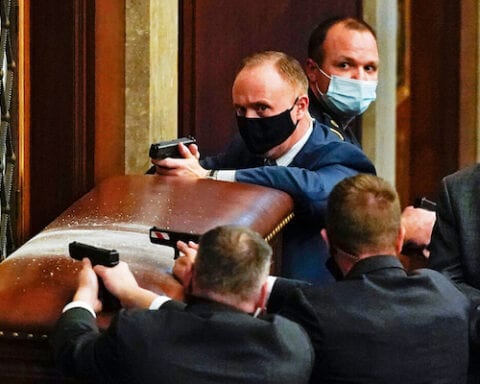
![Image Memorial Day may soon be a remembrance of democracy and those who had the courage to defend it [Lima Charlie News]](https://limacharlienews.com/wp-content/uploads/2018/05/Memorial-Day-may-soon-be-a-remembrance-of-democracy-and-those-who-had-the-courage-to-defend-it-Lima-Charlie-News-480x384.png)
![The Mind of Bolton - AUMF and the New Iran War [Lima Charlie News]](https://limacharlienews.com/wp-content/uploads/2019/05/Inside-the-mind-of-Bolton-Lima-Charlie-News-main-01-480x384.png)

